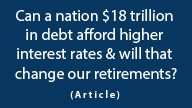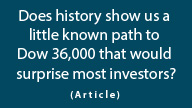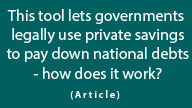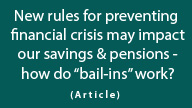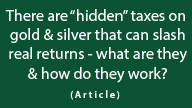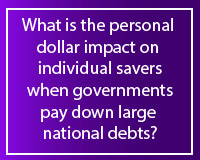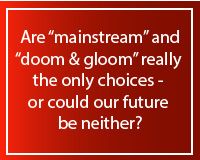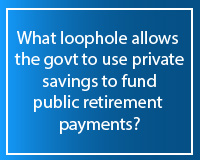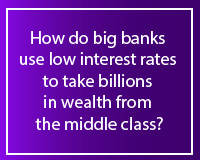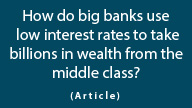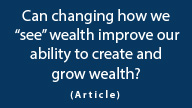Euroskeptic Victories Raise Global Risk Of Return To 2012 Crisis
by Daniel R. Amerman, CFA
Below is the 2nd half of this article, and it begins where the 1st half which is carried on other websites left off. If you would prefer to read (or link) the article in single page form, the private one page version for subscribers can be found here:
Artificial Stability & The Underlying Reality
When considering Europe – as well as the United States – we need to keep in mind that there is an often sharp distinction between the seemingly placid surface, and the underlying economic and financial reality.
In the United States, we have the underlying reality of a nation that is over $17 trillion in officially recognized debt. And if the current artificially-low interest rates were to return to historic levels, as explained here, it would pose an existential risk to the financial solvency of the US government.
And if we include "off-balance sheet items" such as unfunded future liabilities (which only the use of special governmental accounting standards lets the US government avoid taking into account) , then even as agreed to by Cox and Archer the former chairman of the House Ways and Means committee and the former head of the Securities and Exchange Commission respectively, the US is actually over $87 trillion in debt.
When we look at the fundamental economics, we have that increasingly bizarre creature of the official unemployment rate, which has been improving rapidly despite the highest real unemployment rates since the Great Depression remaining in place, thanks to the statistical methodologies of changing workforce participation rates as explained here.
We still have a world of "too-big-to-fail" financial institutions that are interlocked in a massive web of counterparty risk and other exposures, facing the possibility on a daily basis that some combination of counterparty risk, contagion risk and liquidity risk could bring down the whole system, as explained here – absent the power of central banks to prevent that from happening.
However, as I've been writing about for some years now, the dysfunctional fundamentals do not translate to some sort of collapse being inevitable. Far from it.
Rather, central banks and governments working in combination have extraordinary powers which can be used to force artificial stability on the system. Creating dollars by the trillions out of nothingness in the form of quantitative easing is one tool, even while changing the very laws and rules as needed to maintain that stability is another tool.
But the caveat with this type of crisis containment is that while there is nothing inevitable about severe financial crises or monetary collapse, there remains a certain kind of risk that could blow the whole system apart in virtually no time at all.
The Deadliest Risk
What is the most dangerous form of risk for dysfunctional economies and financial systems that are being held together through artificial governmental and central bank interventions?
It is exactly what we are seeing in Europe.
Given that money is ultimately political in nature, and it is politics that are holding the system together right now, the deadliest form of risk to this artificial stability is political risk.
And what we are seeing in Europe may be the best example of this risk that we've seen since the European financial crisis of 2012.
29% of the voters in the UK voted in favor of a party that wants to leave the EU.
25% of the electorate in France just voted in favor of a party that would exit the euro and drastically change the political landscape of Europe.
These fundamental political changes have the potential of slashing the power of the EU and the ECB to maintain artificial economic stability.
And if they do lose control, then the crisis of 2012 could be right back upon us in no time at all, as suddenly the daily headlines become filled again with the potential unraveling of the Spanish and Italian financial and economic systems.
And if the Eurozone were to go down in terms of financial stability, an effective tsunami would flash across the Atlantic Ocean in a matter of hours.
And when it hits the United States and the rest of globe, where is the greatest risk in the financial system concentrated?

As explained here the global financial system continues to have an extraordinary risk exposure to interest-rate derivatives. For a sense of scale, consider the graph above. The barely visible left column is the amount of subprime mortgage derivatives that nearly destroyed the global financial order in 2008, and the towering column next to it is that of interest-rate derivatives exposure.
If central banks lose control of the systems, one of the most likely consequences is that interest rates soar – which could collapse the entire global financial order on a scale like we have never seen before.
Changing Odds Mean Rising Uncertainty
Now does this mean that it is straight to gloom, doom and preparing for imminent and inevitable global financial collapse?
No, such an event is still most certainly not inevitable.
Nor does it even mean that some sort of currency or financial disaster scenario just became the most likely path.
The future remains very much in play, with different paths it can go down, and many of these paths do not involve any form of financial collapse. The EU parliament election results by themselves do not automatically translate to this current climate of artificial stability being doomed to fail.
Instead what we have is a shifting of the odds. That is, whatever the chances had been of a financial meltdown scenario occurring before the election was held – they just went up.
If the EU parliament election results prove to be persistent rather than a mere temporary display of voter anger, and maintain traction when it comes to the national elections that will determine the succeeding governments of the UK, France and other member nations, then the odds that the EU and ECB will lose control just rose sharply.
And if that were to occur, it sharply raises the chances of let's say a return to the situation of 2012 or worse, that ends up leading to a collapse in the value of the euro and the bankruptcies of one or more member nations.
Which could flash across the Atlantic and devastate the US economy – which would then create a doubled crisis for Canada and Australia – potentially in very short order indeed.
When we look at the extraordinary paper wealth creation in global stock markets, particularly in the United States, it's based on essentially close-to-perfect valuation when it comes to being assured that we have a healthy economy in front of us.
Now how much of the stock market value would be there if it had not been for all these years of aggressive Federal Reserve interventions and creation of cheap money is a very good question.
But the stock market remains acutely exposed to systemic financial risk. And as the interest rate derivatives graph above illustrates, the drop that we saw in 2008 is nothing compared to what could happen if the global financial system were to actually go down simultaneously with collapsing economies in Europe and the United States (along with Canada and Australia), pushing each continent deep into depression.
Therefore, the rise of the Eurosceptics does raise the risks of failure for traditional stock and bond strategies – but this event alone does not guarantee their failure.
The victories of the Eurosceptic parties increase the risk that the mechanisms being used by governments and central banks to maintain artificial financial stability could fail on a global basis – although it does not mean that such failure is at all inevitable.
The political seismic shift in Europe increases the risk of future global financial crisis or even collapse – but in no way guarantees such an outcome.
Instead, what can be said with confidence, is that the European Union parliamentary election results have – at least for now – increased the volatility of the future.
This shifting of the odds and increase in uncertainty means that the dangers associated with strategies based upon a purported ability to know the path the future will take – whether of healthy markets or financial meltdown – just increased. As did the advantages to seeking out truly robust wealth protection strategies that are built specifically for volatility and uncertainty.
 What you have just read is an "eye-opener" about one aspect of the often hidden redistributions of wealth that go on all around us, every day.
What you have just read is an "eye-opener" about one aspect of the often hidden redistributions of wealth that go on all around us, every day.
 A personal retirement "eye-opener" linked here shows how the government's actions to reduce interest payments on the national debt can reduce retirement investment wealth accumulation by 95% over thirty years, and how the government is reducing standards of living for those already retired by almost 50%.
A personal retirement "eye-opener" linked here shows how the government's actions to reduce interest payments on the national debt can reduce retirement investment wealth accumulation by 95% over thirty years, and how the government is reducing standards of living for those already retired by almost 50%.
 An "eye-opener" tutorial of a quite different kind is linked here, and it shows how governments use inflation and the tax code to take wealth from unknowing precious metals investors, so that the higher inflation goes, and the higher precious metals prices climb - the more of the investor's net worth ends up with the government.
An "eye-opener" tutorial of a quite different kind is linked here, and it shows how governments use inflation and the tax code to take wealth from unknowing precious metals investors, so that the higher inflation goes, and the higher precious metals prices climb - the more of the investor's net worth ends up with the government.
 Another "eye-opener" tutorial is linked here, and it shows how governments can use the 1-2 combination of their control over both interest rates and inflation to take wealth from unsuspecting private savers in order to pay down massive public debts.
Another "eye-opener" tutorial is linked here, and it shows how governments can use the 1-2 combination of their control over both interest rates and inflation to take wealth from unsuspecting private savers in order to pay down massive public debts.







If you find these "eye-openers" to be interesting and useful, there is an entire free book of them available here, including many that are only in the book. The advantage to the book is that the tutorials can build on each other, so that in combination we can find ways of defending ourselves, and even learn how to position ourselves to benefit from the hidden redistributions of wealth.


